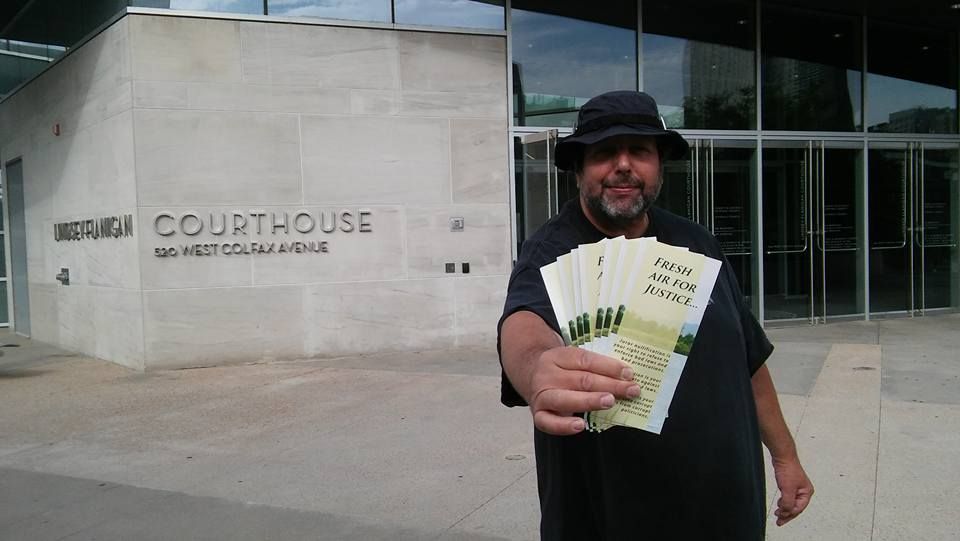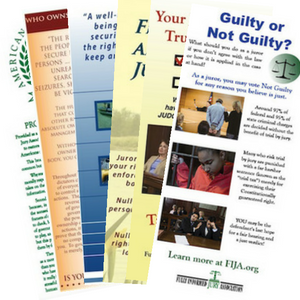Mark Iannicelli and Eric Brandt
Case Summary
Supreme Court Case No. 18SC34
Court of Appeals Nos. 16CA0120 and 16CA0211
City and County of Denver Nos. 15CR3981 15CR4212
false jury tampering charges for sharing FIJA brochures outside the Lindsey-Flanigan Courthouse

Eric Brandt shares FIJA's Fresh Air for Justice brochures outside the Lindsey-Flanigan Courthouse. Photo courtesy of Janet Matzen.
Mark Iannicelli and Eric Brandt were arrested on two separate days in the summer of 2015 outside the Lindsey-Flanigan Courthouse in Denver, CO. They were both falsely charged for exercising their First Amendment rights by handing out FIJA flyers on 27 July 2015 informing people of jurors’ right to conscientiously acquit by way of jury nullification.
Each was charged with seven counts of felony jury tampering as outlined in the Complaint and Information documents attached in the Case Documents below.
Colorado’s jury tampering statute, C.R.S. 18-8-609, states:
“A person commits jury-tampering if, with intent to influence a juror’s vote, opinion, decision, or other action in a case, he attempts directly or indirectly to communicate with a juror other than as a part of the proceedings in the trial of the case.”
As juror rights educators do at many courthouses nationwide, Iannicelli and Brandt had been offering FIJA literature to numerous people who had business at the courthouse that day. Government agents tracked down several people who had been called for jury duty who had received the flyers. Their stance seems to be that any time one of them had received a flyer, that constituted not only jury tampering, but specifically an additional, independent count of jury tampering.
The charges, however, were never addressed in a trial. The case was initially dismissed in short order by the district court in which it was originally brought because the alleged behavior does not violate the jury tampering statute they were cited under.
A district court judge, referring here to Iannicelli and Brandt, ruled that (.pdf):
“[T]hey engaged in an activity that’s certainly no different from citizens of this county, this state, this city, holding up signs in a place where they knew jurors would see them, signs such as, you know, free the Chicago Seven or Eight, don’t convict so and so, and that’s similar — that’s speech. It’s similar to what the defendants did in this case. Activities such as those are protected by the First [A]mendment, because they are speech, they are in a public place, and I think that’s all the Court needs to — that’s as far as the Court needs to go.”
The charges were again verified to be invalid with the Colorado Court of Appeals' subsequent ruling upholding dismissal (.pdf) of the false jury tampering charges:
"In sum, we hold that section 18-8-609(1) applies only to attempts to improperly influence jurors or those selected for a venire from which a jury in a particular case will be chosen. Because the People didn’t charge defendants with attempting to influence such a person (as they concede), it follows that the district court didn’t err in dismissing the charges."
Nonetheless, the district attorney's office has persisted, appealing the dismissal of charges all the way to the Colorado Supreme Court. After multiple extensions and being told that 29 October 2018 was their firm, final deadline, the Denver District Attorney's office finally submitted their opening brief to the Colorado Supreme Court. While they did succeed in maximizing mental punishment of the accused by dragging the process out as long as they could, ultimately the prosecution lost and Iannicelli's and Brandt's victory was completed with a ruling in their favor.
In its majority opinion (.pdf), the Court concluded that:
for purposes of Colorado’s jury tampering statute, section 18-8-609(1), a juror is any person who is either a member of a jury or a grand jury or any person who has been drawn or summoned to attend as a prospective juror
but also that
to commit jury tampering under that statute, a person must attempt to communicate with a juror, directly or indirectly, with the intent to influence that juror’s vote, opinion, decision, or other action in a specifically identifiable case.

Mark Iannicelli shares FIJA's Fresh Air for Justice brochures outside the Lindsey-Flanigan Courthouse. Photo courtesy of Janet Matzen.
Case Documents
Other Resources
- Tampering with free speech, 4 December 2017
- Two cleared in Denver jury tampering case, Colorado Appeals Court rules, 1 December 2017
- Denver judge dismisses charges against jury nullification activists, 16 December 2015
- Men accused of felony jury tampering plead not guilty in Denver, 10 September 2015
- Second Denver man wanted in jury tampering case, 10 August 2015
- Denver DA charges man with tampering for handing out jury nullification flyers, 30 July 2015
- Occupier Mark Iannicelli charged with jury tampering for distributing fliers about jury nullification at courthouse, 27 July 2015
-
Estimated Convictions Obtained by Plea Bargain
97%
-
Extra Punishment for Refusing a Plea Deal
64%
-
Rank of U.S. in Incarceration
1
-
Years FIJA Has Fought for Jury Rights
36


